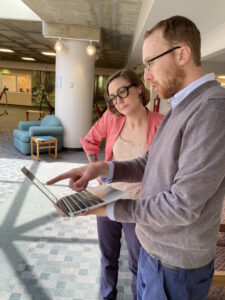This post came from the Aestiva Solutions quarterly newsletter, the Campfire. To subscribe, click here.
Ten years ago Eric used to love going to his friend (who we’ll call Kevin)’s house to watch college basketball games. Kevin had ALL the channels with an over-the-top total cable package. Then one fateful day Eric stopped over for another watch party to see Kevin’s television off and him watching play by play updates on his iPad. Cable simply became too expensive for Kevin, and changes had to be made. Initially it was disappointing for both Eric and Kevin, but in the end everything worked out for the best. Kevin realized he didn’t need to watch every single game; there were plenty available for free or a lower cost. Cord cutting continues to be popular for media consumption, but is not often thought about positively in the library profession, especially with subscription packages that appear key.
Here at Aestiva Solutions, we strongly advocate in making decisions about library workflows based on real world usage data (not just vendor stats), and we’re not afraid to make bold claims when the data supports them (Szpunar and Bradley, 2025). One area to consider cord cutting in the library is discovery layers and unused multidisciplinary indexes. At the same time, it is important to make changes based on user behavior and not just because, so to speak, everyone is jumping to a trendy streaming platform.
Here are some examples of how librarians have worked carefully to obtain analytics to position them to make smart user focused decisions with library resources:
Librarians at Manchester Metropolitan University did a survey of 400 postgraduate students from three universities in Manchester, UK about their online searching behavior. 76% of respondents preferred to use Google Scholar rather than their university’s online library offerings (Alotaibi et al., 2022).
San Francisco State University analyzed their usage data and discovered that requests from Google Scholar grew ten-fold from 2006 to 2011, and that Google Scholar became the top-ranked SFX source for requests in 2011. While this analysis is dated, it shows the importance of knowing where your users are searching, finding, and requesting materials (Wang et al., 2012).

At Goshen College, all users are asked to login to the University Google Apps before using library resources. They have used this data to identify what resources their patrons are using as well as studying relationships between library resource usage and retention and graduation rates (Nafziger and Bradley 2023).
Here at Aestiva Solutions, we’ve worked with clients such as Goshen College to gather this essential data. With library funding tighter than ever, making data driven decisions are even more important, and Aestiva Solutions is here to help you gather and assess your data. Connect with us today to see where you too can cut the cord to non-essentials.
Bibliography
Alotaibi, F. A. A., Johnson, F., & Rowley, J. (2022). Google Scholar or University Digital Libraries: A comparison of student perceptions and intention to use. Journal of Librarianship and Information Science, 55(4), 906-920. https://doi.org/10.1177/09610006221111197
Nafziger, A., Bradley, E. (2023, October 13). Assessing library usage through ezproxy data [Conference presentation]. Discovery to Delivery 2023 Conference, Indianapolis, IN. https://d2d2023.isl.in.gov/agenda/
Szpunar, R., Bradley, E., Gabrielson, E., & Pellegrino, C. (2025). Irrelevant Discovery Layers? An evidence-based evaluation of three common library search tools. Information Technology and Libraries, 44(2). https://doi.org/10.5860/ital.v44i2.17266
Wang, Y., & Howard, P. (2012). Google Scholar Usage: An Academic Library’s Experience. Journal of Web Librarianship, 6(2), 94–108. https://doi.org/10.1080/19322909.2012.672067
